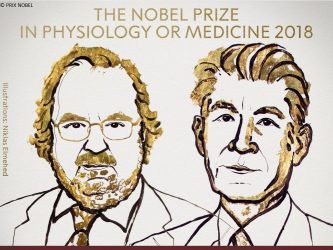Cancer immunotherapy – a beacon of hope

Christmas is still more than two months away, but it was the season of giving few weeks ago – the Nobel Prizes, to be more specific. This year’s Nobel Prize for Physiology or Medicine was awarded to James P. Allison of the MD Anderson Cancer Center and Tasuku Honjo of Kyoto University “for their discovery of cancer therapy by inhibition of negative immune regulation”. Their discovery, made in the 90s, was the keystone for further work by other scientists, who built upon Allison and Honjo’s work to make cancer immunotherapy a viable treatment option today.
Curious about how cancer immunotherapy works? Then read on!
Big Brother Is Watching You
Laypeople are generally aware of the immune system and its essential role in defending us from infections by microorganisms like bacteria and fungi. However, the immune system is much more than a simple border control guard that keeps ill-meaning foreigners out. It also functions as a Big Brother-esque surveillance system on the body’s own citizens, ensuring that all cells behave as they should. Any rogue cells that exhibit unusual behaviour, such as cancer cells, are eliminated swiftly. In this way, the immune system also protects us from cancer.

The immune system is always watching.
Yet, the fact that cancer does occur shows that the immune system is not a surefire line of defense. Clearly, cancer is able to find a way around the immune system. How does it do so?
Evading Big Brother
The immune system has a long arm – its sentinels can be found throughout the entire body, so avoiding encounters with these vigilant watchers is not the most feasible strategy to adopt. But cancer is a wily enemy. If it cannot face its opponent in open combat, it will subvert its opponent from within, taking advantage of a particular type of immune cell.
Some cells of the immune system are devoted to the detection and removal of potential threats, which produces inflammatory reactions, while others are dedicated to dampening such reactions, akin to fire extinguishers. These “fire extinguishers” are essential to health. While inflammation is necessary for the removal of infection and cancer cells, it can also get out of hand, turning from a small bush fire to an uncontrollable forest fire, damaging healthy cells and potentially leading to the development of autoimmune diseases.
T regs: fire extinguishers of the immune system
Some of these extinguishers are the regulatory T cells, or simply T regs in immunologist parlance. Their ability to act as the “brakes” on the immune system is regulated by certain molecules (called “immune checkpoints”). Cancer cells are able to co-opt these molecules on T regs in order to dampen the immune system’s reaction against themselves, thus improving their chances of survival. The discovery of two of these immune checkpoints, CTLA-4 and PD-1, by Allison and Honjo respectively, was what won them this year’s Nobel Prize.
Their work also showed how blocking these immune checkpoints using antibodies (called “checkpoint inhibitors”) prevented cancer cells from recruiting T regs, thereby restoring the immune system’s response against cancer. In this sense, cancer immunotherapy is distinct from conventional cancer treatments such as chemotherapy, in that it does not directly kill cancer cells. Instead, it harnesses the natural ability of the immune system to eradicate cancer.
Continuing work by other scientists and pharmaceutical companies have led to the development of several antibodies against CTLA-4 and PD-1, which have shown promising results against lung and breast cancer, as well as certain cancers once thought to be incurable, such as metastatic melanoma.

Antibodies can stop cancer cells from recruiting T regs.
The unceasing diligence of current researchers working in this field is certain to produce newer and better forms of such therapies in the coming future – shining a beacon of hope for many cancer patients around the world.